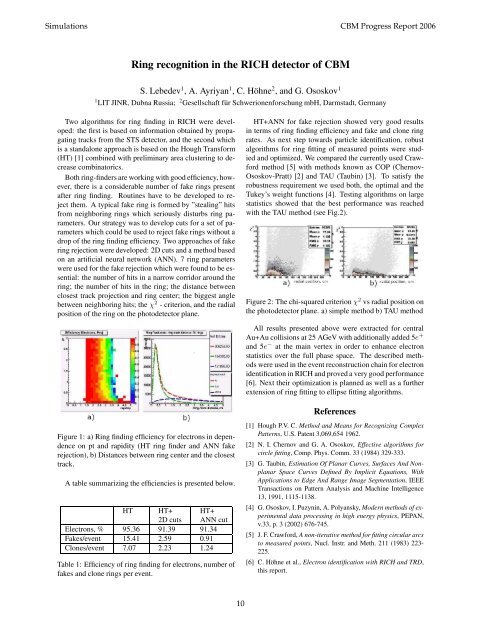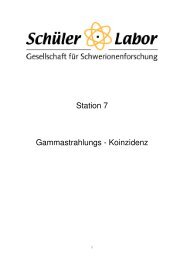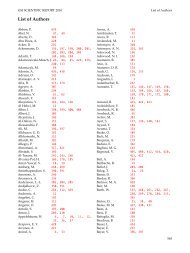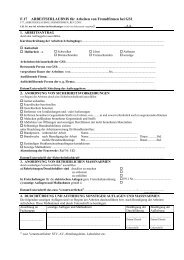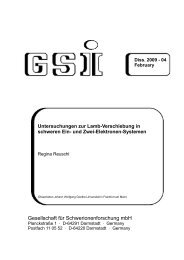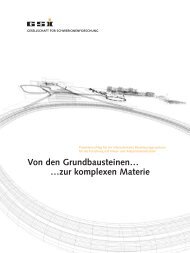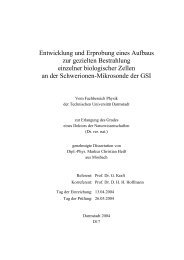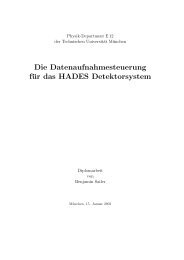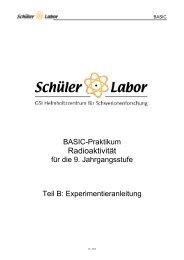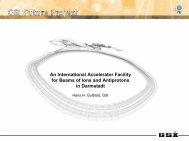CBM Progress Report 2006 - GSI
CBM Progress Report 2006 - GSI
CBM Progress Report 2006 - GSI
You also want an ePaper? Increase the reach of your titles
YUMPU automatically turns print PDFs into web optimized ePapers that Google loves.
Simulations <strong>CBM</strong> <strong>Progress</strong> <strong>Report</strong> <strong>2006</strong><br />
Ring recognition in the RICH detector of <strong>CBM</strong><br />
S. Lebedev 1 , A. Ayriyan 1 , C. Höhne 2 , and G. Ososkov 1<br />
1 LIT JINR, Dubna Russia; 2 Gesellschaft für Schwerionenforschung mbH, Darmstadt, Germany<br />
Two algorithms for ring finding in RICH were developed:<br />
the first is based on information obtained by propagating<br />
tracks from the STS detector, and the second which<br />
is a standalone approach is based on the Hough Transform<br />
(HT) [1] combined with preliminary area clustering to decrease<br />
combinatorics.<br />
Both ring-finders are working with good efficiency, however,<br />
there is a considerable number of fake rings present<br />
after ring finding. Routines have to be developed to reject<br />
them. A typical fake ring is formed by ”stealing” hits<br />
from neighboring rings which seriously disturbs ring parameters.<br />
Our strategy was to develop cuts for a set of parameters<br />
which could be used to reject fake rings without a<br />
drop of the ring finding efficiency. Two approaches of fake<br />
ring rejection were developed: 2D cuts and a method based<br />
on an artificial neural network (ANN). 7 ring parameters<br />
were used for the fake rejection which were found to be essential:<br />
the number of hits in a narrow corridor around the<br />
ring; the number of hits in the ring; the distance between<br />
closest track projection and ring center; the biggest angle<br />
between neighboring hits; the χ 2 - criterion, and the radial<br />
position of the ring on the photodetector plane.<br />
Figure 1: a) Ring finding efficiency for electrons in dependence<br />
on pt and rapidity (HT ring finder and ANN fake<br />
rejection), b) Distances between ring center and the closest<br />
track.<br />
A table summarizing the efficiencies is presented below.<br />
HT HT+ HT+<br />
2D cuts ANN cut<br />
Electrons, % 95.36 91.39 91.34<br />
Fakes/event 15.41 2.59 0.91<br />
Clones/event 7.07 2.23 1.24<br />
Table 1: Efficiency of ring finding for electrons, number of<br />
fakes and clone rings per event.<br />
10<br />
HT+ANN for fake rejection showed very good results<br />
in terms of ring finding efficiency and fake and clone ring<br />
rates. As next step towards particle identification, robust<br />
algorithms for ring fitting of measured points were studied<br />
and optimized. We compared the currently used Crawford<br />
method [5] with methods known as COP (Chernov-<br />
Ososkov-Pratt) [2] and TAU (Taubin) [3]. To satisfy the<br />
robustness requirement we used both, the optimal and the<br />
Tukey’s weight functions [4]. Testing algorithms on large<br />
statistics showed that the best performance was reached<br />
with the TAU method (see Fig.2).<br />
Figure 2: The chi-squared criterion χ 2 vs radial position on<br />
the photodetector plane. a) simple method b) TAU method<br />
All results presented above were extracted for central<br />
Au+Au collisions at 25 AGeV with additionally added 5e +<br />
and 5e − at the main vertex in order to enhance electron<br />
statistics over the full phase space. The described methods<br />
were used in the event reconstruction chain for electron<br />
identification in RICH and proved a very good performance<br />
[6]. Next their optimization is planned as well as a further<br />
extension of ring fitting to ellipse fitting algorithms.<br />
References<br />
[1] Hough P.V. C. Method and Means for Recognizing Complex<br />
Patterns, U.S. Patent 3,069,654 1962.<br />
[2] N. I. Chernov and G. A. Ososkov, Effective algorithms for<br />
circle fitting, Comp. Phys. Comm. 33 (1984) 329-333.<br />
[3] G. Taubin, Estimation Of Planar Curves, Surfaces And Nonplanar<br />
Space Curves Defined By Implicit Equations, With<br />
Applications to Edge And Range Image Segmentation, IEEE<br />
Transactions on Pattern Analysis and Machine Intelligence<br />
13, 1991, 1115-1138.<br />
[4] G. Ososkov, I. Puzynin, A. Polyansky, Modern methods of experimental<br />
data processing in high energy physics, PEPAN,<br />
v.33, p. 3 (2002) 676-745.<br />
[5] J. F. Crawford, A non-iterative method for fitting circular arcs<br />
to measured points, Nucl. Instr. and Meth. 211 (1983) 223-<br />
225.<br />
[6] C. Höhne et al., Electron identification with RICH and TRD,<br />
this report.


